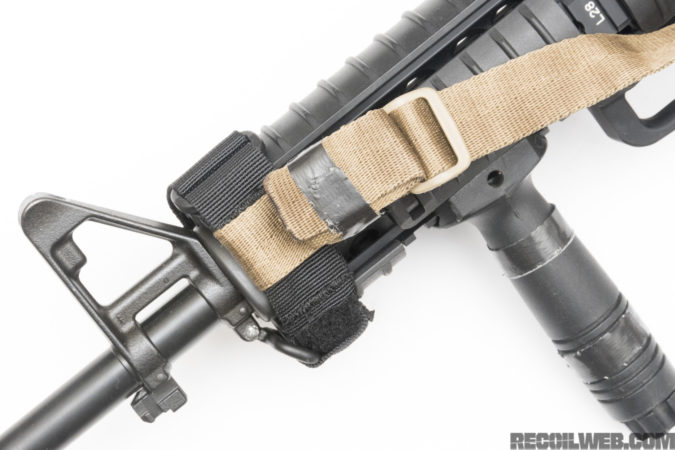Editor Forward: It was more than twenty years ago in November 2004 when the second battle of Fallujah, Operation Phantom Fury, officially kicked off. More than 12,000 coalition troops, the bulk of them Marines, would push into and through the city in the largest urban warfare operation since the Battle of Hue City. Though the worst of the fighting was in the flurry of the first few days, the operation would officially last one month, two weeks, and two days–meaning most of those men, the lucky unlucky ones at least, would spend the Marine Corps birthday, Veteran’s Day, Thanksgiving, and damn-near Christmas in the city.
This war rifle is constructed with newer stuff, along with some original parts and pieces I actually carried in that shitty city so long ago. It’s bulky, heavy, long, and doesn’t totally make sense. There are many like it, but this one is mine.
First featured back in RECOIL issue 36, this was on the shelves in 2018. Officially we called it an Operation Iraqi Freedom M16A4 clone from 2004, or an OIF II gun. But really, it’s a Fallujah rifle rebuild. For more context, this was two years into the so-called “Trump slump” where firearm manufacturers were dropping like flies and prices went below the basement. Anticipating a Clinton win at the ballot box, they had overexpanded and overproduced, thinking they could ride the panic wave forever. It’s a lesson that it seems we have to learn all over again whenever times seem sketchy.
It’s no secret the firearms market has softened since Trump took office. Prices are lower than they’ve ever been, so we’re seeing a lot of interest interest in just-for-fun guns, and clone builds in particular. With a nod to the OIF vets among you, we’re looking at an M16A4 clone; specifically, a clone from Operation Iraqi Freedom, mostly from my own service rifle, circa 2004.

Shortly after the initial invasion of Iraq, the USMC began replacing wellworn M16A2 rifles with the M16A4. Though it still sported a fixed stock and a 20-inch barrel (the better to do rifle drill with), it had a flat-top upper receiver that simplified the mounting of optics and a Knight’s Armament M5 Rail Adapter System (RAS) to hold lights and other accessories.

The clone’s complete upper comes from Aero Precision. It’s made for their M16A4 Special Edition Rifle. The handguard is a P&S Products M5 RAS, an acceptable-and-issued substitution for the original Knight’s Armament handguard, which is harder to find. There’s nothing special about the lower receiver, A2 stock, and internals. We plucked these parts from the RECOIL workshop’s spare parts bins.

The first Trijicon ACOGs issued with these rifles were the TA31F variety, later to be replaced with the TA31RCOA4 with LaRue mounts. Shown is a TA31F with a LaRue QD LT100 mount and TA91 Tenebrex killflash complete with the Trijicon objective flip cap. It is the most battle-tested combat optic of all time.
It’s the small things that make this rifle just right. It’s also the small things that make this rifle look a bit ridiculous. Take the carry handle attached to the rail, for instance. It’s unclear whether it was kept on the rifle as a backup sighting system or to keep the part from getting lost. Two decades later I still haveno idea–and I did this on my own issued rifle.

The buttstock magazine pouch was in common use in Iraq. While on a forward operating base and not outside the wire, weapons were carried empty or, in Marine parlance, kept in “Condition 4.” The buttstock pouch was an easy way to keep a magazine with the rifle without it being loaded. The buttstock magazine pouch also provided a sling location that was actually worth a damn.
Rifle slings were in a state of flux at the time this rifle was in service. The complicated three-point sling was the original issued item with the M16A4. Many Marines either found more useful two-point alternatives, or modified the complex three-points. In later years, Viking Tactics VTAC slings as you see here, were standard.

Both the SureFire M962 as well as the two-cell SureFire M951 (shown with a body extension converting it into a three-cell in top photo) are period correct. Back in the days when 65-lumen lights were the standard, 200 lumen lights like these (even with a 20-minute run time) may as well have been the light of God.

Other items like the magazine coupler and worn-as-hell USGI mags, hideous in hindsight, came directly from a seabag that sat untouched in the garage for more than a decade.


Picking this up and taking it to the range reminds me of everything I hated about this rifle. The barrel is longer than it needs to be. The non-adjustable stock ain’t great for house-to-house. Everything is heavier than it needs to be. But when that steel rang out at 600 yards, I remembered everything I loved, too. It’s not going to be beating feet on foreign streets or hanging out in hovels, but damn it can still do the work if it needs to.

This isn’t the only war rifle we’ve built. Check out the Iraqi Invasion A2
Buildsheets: Past and Present
Read the full article here


